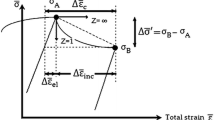Abstract
Tests show that the incremental step test cyclic stress-strain curve depends on the maximum input strain amplitude. The extent of laboratory work may be reduced if one has established a general numerical material model, as such a model may be used to determine cyclic stress-strain curves on the computer. In the present investigation a general transient cyclic plasticity model for simulation of metal behaviour is applied in order to obtain numerically the incremental step test curve for a normalised structural steel and an aluminum alloy subjected to different maximum strain levels. The simulated results are compared with corresponding test data.
Access this chapter
Tax calculation will be finalised at checkout
Purchases are for personal use only
Preview
Unable to display preview. Download preview PDF.
Similar content being viewed by others
References
Landgraf, R.W., Morrow, J., and Endo, T.: Determination of the cyclic stress-strain curve. J. Mater., vol. 4, 1969, pp. 176–188.
Polak, J., Klesnil, M., and Lukas, P.: On the cyclic stress-strain curve evaluation in low cycle fatigue. Mater. Sci. Engng, vol. 28, 1977, pp. 109–117.
Skallerud, B. and Larsen, P.K.: A uniaxial cyclic plasticity model including transient material behaviour. Fatigue Fract. Engng Mater. Struct., vol. 12, 1989, pp. 611–625.
Skallerud, B.: Constitutive modelling of cyclic plasticity and some implications for the computation of biaxial low cycle fatigue damage. Engng Fract. Mech., in the press (1991).
Dafalias, Y., and Popov, E.P.: Plastic internal variables formalism in cyclic plasticity. J. Appl. Mech., vol. 98, 1976, pp. 645–651.
McDowell, D.L.: An evaluation of recent developments in hardening and flow rules for rate-independent nonproportional cyclic plasticity. J. Appl. Mech., vol. 54, 1987, pp. 323–334.
Chang, K.C., and Lee, G.C: Biaxial properties of structural steel — Constitutive relations. J. Engng Mech., vol. 112, 1986, pp. 792–820.
Author information
Authors and Affiliations
Editor information
Editors and Affiliations
Rights and permissions
Copyright information
© 1992 Elsevier Science Publishers Ltd
About this chapter
Cite this chapter
Skallerud, B., Blom, A.F. (1992). Application of a transient cyclic plasticity model for determination of the incremental step test material curve. In: Rie, KT., et al. Low Cycle Fatigue and Elasto-Plastic Behaviour of Materials—3. Springer, Dordrecht. https://doi.org/10.1007/978-94-011-2860-5_73
Download citation
DOI: https://doi.org/10.1007/978-94-011-2860-5_73
Publisher Name: Springer, Dordrecht
Print ISBN: 978-94-010-5269-6
Online ISBN: 978-94-011-2860-5
eBook Packages: Springer Book Archive




